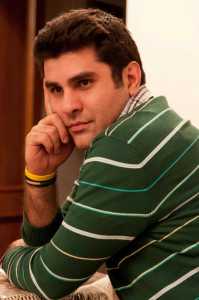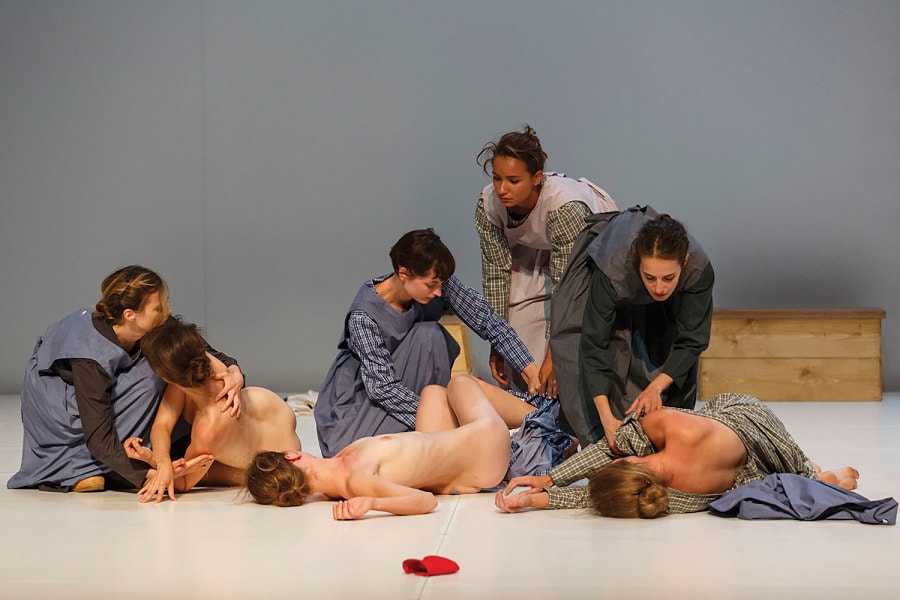Usually we talk about an author’s voice; authorial presence is something else, less tangible but equally impactful. In two shows at the recent Philadelphia FringeArts festival—The Four Seasons Restaurant, directed by the Italian auteur Romeo Castellucci, and White Rabbit Red Rabbit, by the Iranian playwright Nassim Soleimanpour—authorial presence exposed itself in surprising and subversive ways. Four Seasons is a spectacular nonnarrative onslaught of images and vibrations; White Rabbit Red Rabbit is a work for just a single actor, who encounters the text at the same time the audience does. In their own ways, both Soleimanpour and Castellucci assert their presence throughout these pieces, making audiences question the distance between performance and writing.
White Rabbit Red Rabbit is the embodiment of the actor’s nightmare. There are no rehearsals or director. The set is a table, two chairs and a ladder. The performer—a different one each night—arrives having never read the script. When the actor comes onstage, she opens a manila folder containing the script and begins to discover the text at the same time as the audience. A quiet thrill passes through the room as audience and performers simultaneously realize that tonight’s theatre pact is palpably different than it is on most nights in the theatre.
“I’m playing with structures more than playing with words on the page,” Soleimanpour observed in an interview with FringeArts. While that may be true, the theatremaker’s words consistently remind us of his authorial presence. “Okay! So, White Rabbit, Red Rabbit by Nassim Soleimanpour,” actor Jennifer Kidwell (who performed on the night I saw the show) announced at the start of the performance. “That is the title. And my reading it out loud brings us all to a critical moment. Because this is when the actor (me), the audience (you), and the writer (me)—meet. From now on we are all present.”

But Soleimanpour, in fact, was not physically present—he can’t attend performances outside of his native Iran. “I know it sounds silly, but I don’t have a passport,” Kidwell explained on behalf of the playwright. “It’s a rule in my country. A young man has to do military service for two years before he can get a passport.” Soleimanpour’s absence in Philadelphia was a result of his not having done military training.
In a series of audience-participation episodes, Kidwell, acting on behalf of Soleimanpour, enlisted onlookers to act as a rabbit, or lend a dollar. Soleimanpour’s allegory is sprinkled with a charming dose of slang (with affirmations like “groovy”), and his self-aware politesse reminds the audience who’s in control: “Thank you for your obligatory participation.” There’s also a healthy measure of humor. After asking an audience member, “How old are you?” Kidwell chuckled before reading the next line: “You look younger.”
Not all of Soleimanpour’s reminders are happy intrusions. When Kidwell discovered that she must portray a cheetah who does an ostrich dance, we heard her say, “Fucking terrorist! And I didn’t call him a terrorist, by the way. It’s scripted. He called himself a terrorist. ‘Imitate an ostrich now,’ says the terrorist.”
Learning more facts about our author—he uses G-mail, was born in 1981, is a Sagittarius, is hairy—helped us feel his presence and, in a sense, co-create with him the banal and tragic weave of the evening’s performance. We heard about a cruel experiment Soleimanpour’s uncle conducted with rabbits, which produced frissons of disquiet about social control. “I actually made you do something,” Kidwell reminded spectators later in the performance. “I even took money out of your pockets and placed it in someone else’s pocket.” How easy it is to manipulate an audience. Are we any better off than rabbits? Are we test subjects for the playwright, playing master puppeteer from thousands of miles away?
A meditation on suicide followed: “Life is the most common way to commit suicide. Life means choosing the longest solution for dying. It means the struggle for suicide through the natural decomposition of the body and the gradual exhaustion of the soul.” (The passage resonates doubly when we learn that Soleimanpour’s trigger for White Rabbit was an anxiety dream in which he was committing suicide in front of a live audience.)
Upping the ante, Soleimanpour calls for two glasses of water to rest onstage, one having been ostensibly poisoned at the start of the play by an audience member. Will Kidwell the performer drink the water? Will we let her? “I testify here that if you are a passive viewer of this suicide, you are more a sinner than me; and society is obliged to confront you with the severest punishment,” the actress says. The front row seat that Soleimanpour asks us to save for him became a somber symbol of his presence and his absence.
Manipulation and suicide also crop up in Castellucci’s The Four Seasons Restaurant, whose title references the paintings Mark Rothko famously removed from the titular restaurant in New York City. Says Castellucci, “Sometimes subtraction and refusal can be—and can express—an aesthetic act.”
Castellucci’s subtractions boldly expose his authorial presence in performance, which begins in total darkness with a soundscape of recordings taken by NASA from a black hole in the Perseus galaxy some 250 million light years away from Earth. One doesn’t hear these recordings, reset to a frequency audible to humans by NASA and manipulated by ingenious sound designer Scott Gibbons, so much as feel them rumbling in the chest and rattling in the bones. The experience explodes like existence itself—crackles and vibrations surround the audience.
The next subtraction is quite literal: A series of young women enter the space and, one by one, cut off their own tongues. They proceed to deliver text from The Death of Empedocles, a play by the Romantic German poet Friedrich Hölderlin, their voices distorted and detached from their bodies as they describe how the philosopher turned his back on society and threw himself into Mount Etna.
In a talkback, Castellucci referred to Empedocles’s “exit strategy” as a potentially artistic act, far different from the moral litmus test Soleimanpour presents. “Empedocles commits suicide for life and with life. It’s a unity of nature.”
And in an essay handed out at performances, the scholar Daniel Sack writes that “the act of disappearing becomes a profoundly creative gesture. We might call it ‘art,’ an art that the spectator produces.”
The Four Seasons prompts the spectator to produce her own art on a number of occasions. What to make of the moment when the U.S. Confederate flag appears? Or when the girls create a tangle of bodies, giving birth to themselves? What about the final spectacle, wherein the sounds of the universe—those Perseus poppings—detonate around us, as wind machines kick into gear and what appears to be black spirits swirl and rise in a tumultuous cycle, like cinematic special effects? For this viewer, the effect was exhilarating, like watching a ghost haunt some terrifying forgotten planet in the outer reaches of the universe.
But, as in those classy horror movies in which the monster is never shown, Castellucci doesn’t tell his audience what to think or feel. Instead he offers provocative, theatrically indelible suggestions that spur our own vivid imaginations—our own art.


